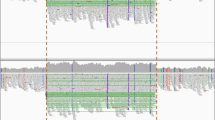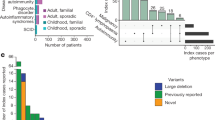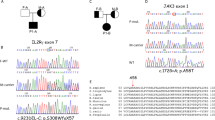Abstract
Many primary immunodeficiency disorders of differing etiologies have been well characterized, and much understanding of immunological processes has been gained by investigating the mechanisms of disease. Here, we have used a whole-genome approach, employing single-nucleotide polymorphism and gene expression microarrays, to provide insight into the molecular etiology of a novel immunodeficiency disorder. Using DNA copy number profiling, we define a hyperploid region on 14q11.2 in the immunodeficiency case associated with the interleukin (IL)-25 locus. This alteration was associated with significantly heightened expression of IL25 following T-cell activation. An associated dominant type 2 helper T cell bias in the immunodeficiency case provides a mechanistic explanation for recurrence of infections by pathogens met by Th1-driven responses. Furthermore, this highlights the capacity of IL25 to alter normal human immune responses.
This is a preview of subscription content, access via your institution
Access options
Subscribe to this journal
Receive 6 digital issues and online access to articles
$119.00 per year
only $19.83 per issue
Buy this article
- Purchase on Springer Link
- Instant access to full article PDF
Prices may be subject to local taxes which are calculated during checkout


Similar content being viewed by others
References
Baumgart K, Britton W, Kemp A, French M, Robertson D . The spectrum of primary immunodeficiency disorders in Australia. J Allergy Clin Immunol 1997; 100: 415–423.
Tran H, Nourse J, Hall S, Green M, Griffiths L, Gandhi M . Immunodeficiency-associated lymphomas. Blood Rev 2008; 22: 261–281.
Rosen F, Cooper M, Wedgwood R . The primary immunodeficiencies. New Engl J Med 1995; 333: 431–440.
Kidd P . Th1/Th2 balance: the hypothesis, its limitations, and implications for health and disease. Alt Med Rev 2003; 8: 223–246.
Szabo S, Kim S, Costa G, Zhang X, Fathman C, Glimcher L . A novel transcription factor, T-bet, directs Th1 lineage commitment. Cell 2000; 100: 655–669.
Zheng W, Flavell R . The transcription factor GATA-3 is necessary and sufficient for Th2 cytokine gene expression in CD4 T cells. Cell 1997; 89: 587–596.
Yamashita M, Ukai-Tadenuma M, Miyamoto T, Sugaya K, Hosokawa H, Hasegawa A et al. Essential role of GATA3 for the maintenance of type 2 helper T (Th2) cytokine production and chromatin remodeling at the Th2 cytokine gene loci. J Biol Chem 2002; 279: 26983–26990.
Angkasekwinai P, Park H, Wang Y, Wang Y, Chang S, Corry D et al. Interleukin 25 promotes the initiation of a proallergic type 2 response. J Exp Med 2007; 204: 1509–1517.
Fort M, Cheung J, Yen D, Li J, Zurawski S, Lo S et al. IL-25 induces IL-4, IL-5, and IL-13 and Th2-associated pathologies in vivo. Immunity 2001; 15: 985–995.
Lee C, Iafrate A, Brothman A . Copy number variations and clinical cytogenetic diagnosis of constitutional disorders. Nat Genet 2007; 39: S48–S54.
Conley M, Notarangelo L, Etzioni A . Diagnostic criteria for primary immunodeficiencies. Clin Immunol 1999; 93: 190–197.
Iafrate A, Feuk L, Rivera M, Listewnik M, Donahoe P, Qi Y et al. Detection of large-scale variation in the human genome. Nat Genet 2004; 36: 949–951.
Yamagata T, Mitani K, Oda H, Suzuki T, Honda H, Asia T et al. Acetylation of GATA-3 affects T-cell survival and homing to secondary lymphoid organs. EMBO J 2000; 19: 4676–4687.
Asnagli H, Murphy K . The functional genomics experience (are you experienced?). Nat Immunol 2001; 2: 826–828.
Chen C, Zhang D, LaPorte J, Ray A . Cyclic AMP activates p38 mitogen-activated protein kinase in Th2 cells: phosphorylation of GATA-2 and stimulation of Th2 cytokine gene expression. J Immunol 2001; 165: 5597–5605.
Garvy B, Wiley J, Gigliotti F, Harmsen A . Protection against Pneumocystis carinii pneumonia by antibodies generated from either T helper 1 or T helper 2 responses. Infect Immun 1997; 65: 5052–5056.
Power C, Wei G, Bretscher P . Mycobacterial dose defines the Th1/Th2 nature of the immune response independently of whether immunization is administered by the intravenous, subcutaneous, or intradermal route. Infect Immun 1998; 66: 5743–5750.
Moser C, Jensen P, Kobayashi O, Hougen H, Song Z, Rygaard J et al. Improved outcome of chronic Pseudomonas aeruginosa lung infection is associated with induction of a Th1-dominated cytokine response. Clin Exp Immunol 2002; 127: 206–213.
Sinha P, Ghosh A, Das T, Sa G, Ray P . Protein A of Staphylococcus aureus evokes Th1 type response in mice. Immunol Lett 1999; 67: 157–165.
Torigoe S, Ihara T, Kamiya H . IL-12, IFN-γ and TNF-α released from mononuclear cells inhibit the spread of Varicella-zoster virus at an early stage of Varicella. Microbiol Immunol 2000; 44: 1027–1041.
Mouzaki A, Theodoropoulo M, Gianakopoulos I, Vlaha V, Kyrtsonis M, Maniatis A . Expression patterns of Th1 and Th2 cytokine genes in childhood idiopathic thrombocytopenia purpura (ITP) at presentation and their modulation by intravenous immunoglobulin G (IVIg) treatment: their role in prognosis. Blood 2002; 100: 1774–1779.
Weaver C, Harrington L, Mangan P, Gavrieli M, Murphey K . Th17: an effector CD4 T-cell lineage with regulatory T-cell ties. Immunity 2006; 24: 677–688.
Guo J, Rapoport B, MacLachlan S . Balance of the Th1/Th2 cytokines in thyroid autoantibody synthesis in vitro. Autoimmunity 1999; 30: 1–9.
Acknowledgements
We acknowledge the contribution of clinical immunologists that have provided their findings, including Prof Rebecca Buckley (Duke University Medical Centre, NC, USA), Dr Alison Jones (Great Ormond Street Hospital for Children, London, England) and Dr Alain Fischer (Necker University Hospital, Paris, France). Also, Michael R Green was supported by the Herbert Family Philanthropic Scholarship.
Author information
Authors and Affiliations
Corresponding author
Ethics declarations
Competing interests
The authors declare no conflict of interest.
Additional information
Supplementary Information accompanies the paper on Genes and Immunity website
Supplementary information
Rights and permissions
About this article
Cite this article
Green, M., Camilleri, E., Gandhi, M. et al. A novel immunodeficiency disorder characterized by genetic amplification of interleukin 25. Genes Immun 12, 663–666 (2011). https://doi.org/10.1038/gene.2011.50
Received:
Accepted:
Published:
Issue Date:
DOI: https://doi.org/10.1038/gene.2011.50
Keywords
This article is cited by
-
Incomplete penetrance in primary immunodeficiency: a skeleton in the closet
Human Genetics (2020)
-
Use of Genetic Testing for Primary Immunodeficiency Patients
Journal of Clinical Immunology (2018)



